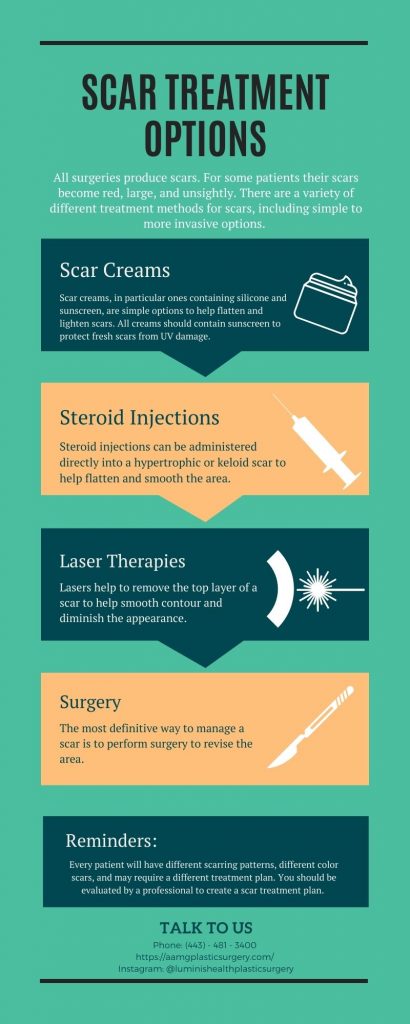One concern that many patients have when they undergo surgery is “what will the scar look like?” All surgeries result in scars, and sometimes scars can become unsightly or painful for certain patients. This article discusses a bit more about what a scar is and different treatments for scars.
What is a scar?
A scar is the body’s natural way of healing itself after injury. Scars are formed from a protein in your body called collagen. A scar can take up to a full 2 years to heal. Scars often start out as red and raised and will gradually flatten over time.
Some patients have keloid scarring, which is characterized by round, irregular, and thick scars that grow beyond the edges of a wound. Keloid scars are most common in darker-skinned people and can occur anywhere on the body.
In comparison, a hypertrophic scar is one that is thick, red, and raised, however, it has not grown beyond the edges of a wound.
 How do you treat a scar?
How do you treat a scar?
For most patients, time and patience will heal all scars. It can be difficult to wait and watch you scar, but one of the most important factors for overall scar health is allowing the body to heal naturally.
Some patients like to modulate the scarring process by introducing scar creams, such as ones that contain silicone and sunscreen. Silicone helps a scar heal by providing moisture and reducing collagen production, meaning it helps a scar become softer and flatter. Sunscreen is essential for all scars, as they are very susceptible to sun exposure and burning.
Most patients respond well to topical scar creams, however, some patients need additional therapy. For patients who have hypertrophic or keloid scars, a steroid injection will help to flatten and lighten the area. Other patients respond well to laser therapies where the top layer of the scar can be removed and lightened.
If all the non-invasive scar treatments do not work, the most definitive way to treat a scar is to perform surgery to remove the old scar and create a new one. Surgeons often use different material during a secondary procedure that produces less inflammation and lessens the chances of a reactive scar.
Takeaway
All patients, and all scars, are different. No two patients will have the same outcome and every treatment is unique. If you have a scar that you wish was different, please contact the plastic surgery team at Luminis Health to discuss different options.
 Tripp Holton, MD, is a plastic surgeon and the director of microvascular surgery at Luminis Health Anne Arundel Medical Center. He has extensive expertise in reconstructive microsurgery, including reconstruction of the head and neck, breast, and extremities.
Tripp Holton, MD, is a plastic surgeon and the director of microvascular surgery at Luminis Health Anne Arundel Medical Center. He has extensive expertise in reconstructive microsurgery, including reconstruction of the head and neck, breast, and extremities.



